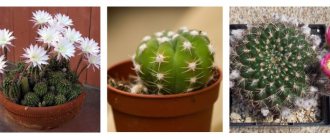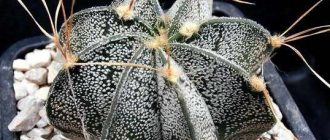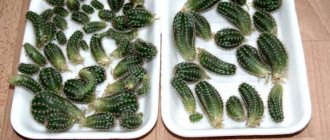Under natural conditions, such a plant as cereus is a giant (compared to man). Most often, such cacti reach a height of 6 to 10 meters, but there are also those that grow up to 20 meters. Cereuses are long-lived in the plant world.
In nature, such plants are found in South and Central America, as well as in Western India.
The name of this cactus “Cereus” in Latin means “wax candle”.
Such spectacular large cacti can be seen quite often in greenhouses, winter gardens, as well as in the spacious halls of various institutions. Often window displays are decorated with cereus.
Quite compact species are grown at home.
Cereus cactus (two years later)
What does Cereus Peruviana look like?
Cereus is one of the brightest representatives of the Cactus family. The succulent is distinguished by its large dimensions, good frost resistance and fruitful growth. The plant reaches a height of 20 m. Its root system is considered powerful and dense, and it develops very quickly. The succulent is often called Cereus Monstrosa.
Peruvian Cereus in a pot
There are sharp spines along the entire length of the flower. Their length varies within 3 cm. The central spines are in the form of a spike, their length reaches 10 cm.
Common varieties
The main types of cereus include:
- nocturnal cereus;
- Cereus Manga;
- Cereus spiralis;
- Cereus azure;
- Cereus giant.
- Cereus japonstrosus;
- Cereus yamakaru.
Important! Each variety of cactus crop requires specific growing conditions.
Photo
In the photo you can see bright representatives of the Cereus cactus species, such as Peruvian , Monstrous (rocky shape) :
Peruvian Cereus: care at home
Cereus cactus: popular plant species and caring for them at home
Cereus cactus is a plant with good immunity. The speed and productivity of the growth of Cereus Peruvianus depend on caring for it at home. To properly maintain a flower, you need to familiarize yourself with the rules of watering, replanting and propagation.
Temperature
The owner should know that cactus cereus easily tolerates sudden temperature changes. It thrives in extreme heat and moderate cold. In winter, a succulent can develop normally at temperatures from 8 to 12 degrees. In summer, maximum values are around 30 degrees.
For fruitful growth, the cereus flower needs good air circulation, so periodically it needs to be taken out to the balcony (for 2-3 days).
Lighting
Cereus Peruvian loves good lighting, preferably natural. Gardeners advise placing the plant in the brightest place in the house.
The cactus can be left in direct sunlight in the summer. But here it is important not to overdo it, so that this does not lead to excessive dryness of the soil. From time to time you will need to bring it into the house and protect it from exposure to ultraviolet rays.
Watering
Cereus cactus loves moderate watering. Excess and lack of moisture can adversely affect the growth and flowering of the plant.
Any actions with a cactus must be carried out with caution
Active watering must be carried out in the summer, when there is intense heat.
- In autumn, water the plant 2 times less often.
- In winter, watering is stopped altogether.
You need to give the root system a little rest so that it does not start to rot. Gardeners advise watering cereus with cool and hard water. The soil should always be moderately moist.
Attention! Excess moisture can lead to rotting of the root system.
Humidity
The Peruvian cactus tolerates arid environments and thrives in it. But increasing the percentage of humidity in the room will never harm it.
Therefore, it is periodically necessary to spray the plant with liquid from a spray bottle or turn on automatic air humidifiers.
Priming
The plant grows well in acidic or neutral soil. Humus soil is not suitable for the full growth of cactus.
If gardeners use ready-made mixtures for planting crops, it is better to add a little sand or grated brick to the solution.
Feeding
During growth and the growing season, the plant crop needs intensive and regular feeding. For these purposes, it is recommended to use potassium and organic fertilizers.
Specialized stores sell special liquid fertilizers for cactus species; you can use them during the growing season of the plant.
When flowering is over, you need to feed the cactus once, and then leave it alone until spring. No fertilizer is required during wintering.
Attention! An excess of nutrients can lead to poor development of the root system, so it is important to always observe the measure.
What types of cacti are there?
In accordance with botanical classifications, all representatives of the cactus family, and this is more than 5000 names, are grouped into subfamilies according to a number of the most stable characteristics: the structure of the ovaries, shape, color, location on the stem of flowers, characteristics of the reproductive organs and seeds. There are 4 subfamilies in total.
Peireskiaceae
The oldest and most primitive division of the Cactaceae family, which has much in common with deciduous plants. It consists of a single genus of Pereskia, which plays the role of a kind of evolutionary link that connects cactus and leaf plants. Its representatives are characterized by full-fledged alternate leaves and non-succulent stems. Flowers can be with a lower or upper ovary, solitary or collected in simple inflorescences (tassels).
Pereskia prefer moist equatorial forests, savannas and tropical deciduous woodlands of the Caatinga.
Opuntiaceae
All plants of this division are characterized by clearly noticeable reduced leaves, which are necessarily present on young shoots, falling off in adulthood, succulent trunks with less or more pronounced segmentation, and the presence of unicellular outgrowths of glochidia. This is a special type of spines in the form of needle-like miniature thorns, unusually sharp, hard and jagged along the entire length. Bundles of glochidia densely cover the areas of the stem next to the areoles.
If they get into the mouths of animals, they greatly irritate the mucous membrane, thus protecting the plants from the unenviable fate of being eaten.
Mauchiaceae
These original cacti have long been classified as members of the Opuntiaceae subfamily. After recent studies showed the phylogenetic distance of representatives of this subfamily from other cacti, they were combined into a separate division, consisting of two species. Habitat: Patagonia.
This subfamily includes only one genus, whose members, with small (maximum 1 cm), durable triangular green leaves and small cylindrical shoots, are visually similar to Opuntiaceae, except that they do not have glochidia. As they grow, they form large compacted clumps.
Mayuenias are frost-resistant and slow growing. They grow without problems outdoors throughout the year.
Regardless of the growing conditions - indoors or outdoors, these plants require grafting on unpretentious, strong prickly pear.
Flowering in cultivated mauchiniaceae is an extremely rare occurrence.
Cactaceae
A division consisting of all remaining genera of the family Cactaceae. The plants included in it are characterized by the absence of glochidia, and there are only small rudimentary leaves on the flower tubes. Sprouts in the shape of a ball or cylinder have barely noticeable cotyledons in their infancy.
The subfamily consists of epiphytic plants with whip-like or leaf-shaped stems and a huge number of xerophytes, impressive in their variety of forms (creeping, spherical, columnar, turf-forming).
Those who grow cacti also use a simpler classification based on their appearance.
Shrubs
Hylocereus
The genus includes about 20 species, among which there are terrestrial, lithophytic, semi- and epiphytic forms. All of them belong to forest cacti living in subequatorial forests.
Features and common features of representatives of the genus Hylocereus:
- stem color – all shades of green from light to intense tones;
- the presence of long thin creeping three- or four-rib shoots 3-12 m long, 20-70 mm in diameter;
- the ribs on the stems have wavy or sharp edges;
- flower shape – funnel-shaped, color – white, length and diameter – 10-30 cm;
- the number of spines in the areole is 2-10, some species do not have them;
- the length of the needles is from 0.1-1 cm, they can be sharp, needle-shaped or soft in the form of bristles;
- The root system is formed by aerial roots in large quantities.
Some species of Hylocereus lead an epiphytic lifestyle and use host plants only as a substrate to attach to. Particularly noteworthy is the multi-rooted species of creeping, densely branched plants with rectangular stems of rich green color, which becomes whitish in adult plants. Their fruits, known as pitahaya (“dragon heart”), have high nutritional and medicinal value, as they contain large reserves of vitamin C and lycopene with a powerful antioxidant effect.
This pigment also helps in the fight against cancer and reduces the risk of developing cardiovascular diseases.
Tree-like
The tallest and largest representatives of the cactus family can be recognized by their erect stems (one or several) with lateral shoots that have an external resemblance to branches. In nature, many specimens reach a height of 25-30 m.
Cereus
The oldest genus of cacti, whose main feature is the presence of a long cylindrical stem. In large tree-like species, its height reaches 15-20 m. There are also many low-growing shrub forms and epiphytes with creeping stems and aerial roots. The species diversity includes about 50 names.
Large species are distinguished by a powerful trunk, well-developed root system and crown, which is formed by numerous leafless side shoots.
The stem is strongly ribbed and green-blue in color, covered with spines of black, brown or gray color. The color of the flowers is white, pinkish, white-green.
During the day, when it is hot, cereuses keep them closed, opening them only at night.
These plants are unpretentious to living conditions, grow quickly, are hardy as a rootstock and are highly decorative. They are widely used in the phytodesign of apartments, offices, public places and to create cactus “alpine” slides.
Herbaceous
They grow in flat areas with heavy soils. These are plants with round, flat stems that may be pubescent or have faint spines. The color of the shoots can be light or intense green.
Mammillaria
One of the most evolutionarily advanced genera, serving as clear evidence of the high adaptability of cacti to extreme climatic conditions. In nature, colonies of these cacti occupy vast areas. In the natural environment, they can be found along sea coasts, on the slopes and ledges of chalk mountains at an altitude of 2.5 thousand m above sea level.
Mammillaria are miniature plants with spherical or cylindrical stems no more than 20 cm high.
A peculiarity of this genus is the absence of ribbing on the stem.
Its surface is chaotically covered with numerous tubercles (papillae), from which needles grow in bunches. The arrangement of the tubercles differs in different varieties: in some forms they encircle the axial part of the shoot, forming horizontal rings, in others they are arranged in a spiral. The lower papillae are pubescent, and needle-shaped spines grow from the apical ones. The places where flower buds form are more pubescent.
Liana-like
In ampelous (curly forms) shoots, due to their flexibility, softness and length, resemble vines. Among the representatives of this group there are many plants that lead an epiphytic lifestyle in symbiosis with nearby vegetation.
Selenicereus
These cacti are native to equatorial rainforests. Among them there are terrestrial, epiphytic, and lithophytic forms. Plants cling to nearby supports and are held on them with the help of aerial roots growing densely on thin shoots. The length of the shoots of the largest specimens can reach 10-12 m, although their thickness is only 2.5-3 cm.
In different parts of the planet, these plants are called “dragon” or “snake” cactus, “night blooming”, each of these names in one way or another reflects the characteristics of these liana-shaped cacti.
The presence of long shoots combined with a grayish-green color gives the plants a resemblance to snakes. Some varieties are characterized by a zigzag shape of the stems, reminiscent of a fern leaf, although it can also be compared to the tail of such a fantastic creature as a dragon. Selenicerius tend to bloom at night; if environmental conditions are favorable, then at the same time they are capable of producing up to fifty flowers, and very large ones, with a diameter of 25-30 cm.
You can only admire the beauty of the blooming selenicerius for a few hours at night, since with the arrival of morning the petals wither and fall off.
The flowers of representatives of this species are considered the largest in the cactus family. But in cultivation, these plants bloom extremely reluctantly, even if agricultural practices are followed impeccably.
Features of care during the rest period
The cactus plant fully blooms in mid to late September. At this time, experienced gardeners advise not to move the pot with the succulent and not to overload it with frequent watering.
Rhipsalis - care and propagation at home
Feeding before subsequent cold weather can be completely eliminated, but watering will need to be done at least once a month. This will contribute to the formation of new shoots.
Important! You can focus on the dryness of the soil. As soon as it becomes completely dry and begins to crack, you can generously water the flower with cool water.
The optimal temperature in winter for plant development is from 15 to 18 degrees Celsius. However, when the temperature rises to 25 degrees, the cereus will also feel good. You only need to periodically humidify the air in the room.
When and how does it bloom
Epiphyllum: home care and examples of reproduction
In the first year of growth, the shoots of Cereus have a bluish tint. The more time passes, the more they thicken and darken.
Cereus peruviana flowering
On the stem of the plant there are areoles with spines (5-6 pieces in each). In April and May, the cactus begins to bloom. In place of the areoles, cream and yellow inflorescences appear. Their length can reach 16 cm. The leaves of the flowers are covered with barely noticeable scales; they have tubular-shaped petals.
As they develop, the flowers acquire a bright red hue. The blooming of buds is observed mainly at night. Next, fruits appear on the branches of the cactus. These are small round berries of a yellow or orange hue.
For reference! The fruits when ripe are considered edible - according to reviews from those who have tried them, they have a sweet taste and delicate aroma.
Description of the plant
Cereuses have been divided, reclassified, and transferred so many times that from the once huge genus of cacti, including dozens of species, only fifty cacti remain, easily recognizable by one single feature - cylindrical ribbed stems. Cereuses are often underestimated, considered just rootstocks for more showy cacti. But these large, fast-growing, versatile species are good on their own.
Cereuses are creeping and shrubby, low and tall. They change with age, transforming from one cylinder into bizarre groups and crowns. Large cereus plants in nature flaunt a pronounced trunk and crown, but in rooms, if they produce side shoots, they do so either from the base or creating beautiful tree-like silhouettes. The maximum size is limited only by the time and space that you are willing to provide the cereus.
All cereus retain their easily recognizable features. They are characterized by fairly powerful roots and columnar, straight, powerful cylindrical stems with large, deep ribs, on which spines stand out clearly. The bluish, light, muted color of the stems contrasts well with the brown, black and gray “needles”.
Cereus flowering is one of the most beautiful among cacti. Large, up to 25 cm long, white, light green or pink flowers seem massive and bright. They bloom at night, surprising with vanilla aroma. But enjoying the flowering of cereus from May to June in rooms is not easy, because you need to wait for decades, and old cacti without sufficient access to fresh air and bright light almost never bloom.
Cereus has edible fruits. But it is better not to rush to feast on bare berries that have not reached the “ripe” red color from home cacti.
Cereus validus. © Süleyman
Steelhead cereus (Cereus chalybaeus). © bracti
Rocky cereus, or Peruvian (Cereus repandus), Florida form. © Eddington House Nursery
How does Cereus peruviana reproduce?
Cactus culture is propagated in two ways: by seeds and cuttings.
Germination of seeds
Reproduction must begin in mid-spring (late April or early May). The step-by-step process is as follows:
- A small container must be filled with sand and mixed with a small amount of earth.
- Plant the pre-soaked seed in the prepared soil.
- Water the soil and leave the pot in a cool and well-ventilated area until spring.
- When the first shoots appear, the container with the seeds will need to be moved to a more illuminated part of the house, while the temperature should remain at around 20 degrees Celsius.
When thorns appear, even loose ones, it will be possible to pick. Next, the young succulent is cared for as an adult plant.
Rooting cuttings
Cuttings are carried out in early summer. It is better to focus on mid-June. The procedure looks like this:
- Several young shoots are cut off with a sharp, disinfected knife.
- The prepared cuttings are cut into several parts.
- They are sent to a warm room for thorough drying.
- The pot is filled with loose soil, the cuttings are placed in it, and the plant is watered abundantly.
- Now it needs to be sent to a well-ventilated place to compact the root system.
Important! After a month, the plant can be planted in separate containers.
Transfer
The number of transplants depends on the growth rate of the cactus species. Usually the pot is changed once every year or two. The procedure is carried out according to the following scheme:
- Choose a larger pot; it must have sufficient depth.
- Place loose soil mixed with humus in a container.
- Plant the plant, water it abundantly and place it in a well-consecrated part of the house.
After 3-4 days, the Cereus cactus can be fertilized using mineral fertilizers. Repeated watering is done when the soil in the pot dries well. High humidity can damage the root system of a plant crop.
Transplanting a cactus breed
Diseases and pests
Cereus Peruvianus is considered a fairly resistant plant. But if proper care conditions are not observed, it may become infected with various diseases or the appearance of pests on it:
- Shield. These are insects that have a convex body. They appear in spring. The scale insect attaches itself to the shoots of the flower and sucks out its juices. If the insects are not removed in a timely manner, the cactus may die.
- Mealybug. The parasite appears on the shoots of the plant and leaves a white coating on them. Over time, it leads to the destruction of the integrity of the stems and leaves, which can lead to the death of the cereus.
- Spider mite. The insect appears on the trunk of a succulent. The mite leaves its web and red dots on it, which lead to the slow death of the crop.
With reduced immunity, the plant crop may develop fungal and bacterial infections. The presence of pathology can be determined by changes in the color scheme of the aerial parts, the appearance of brown spots on the trunk, and the development of rot on individual shoots. In such cases, it is necessary to carry out preventive spraying and transplant the crop into a new pot with clean soil.
Possible difficulties during cultivation
When growing a cactus, some difficulties may arise due to pest attacks or the development of diseases.
Cereus may develop pests, each of which affects the plant differently:
- spider mite (creates small inclusions of a reddish color and a cobweb-like coating, in severe forms - yellow spots);
- scale insects and false scale insects (these are round-shaped beetle-like parasites that suck the juices from the plant);
- mealybug (whitish spots with fluff appear).
To combat all pests, the same method is used, which consists of treating with any systemic insecticide (for example, Inta-vir or Fufanon).
The cactus can be affected by fungal rot. The cause of the development of the disease is often excessive moisture. Symptoms include the appearance of brown spots on the shoots. For treatment, it is necessary to manually remove the infected areas. The sections are treated with crushed activated carbon for disinfection purposes. Having eliminated the cause of the disease, moderate watering.
Signs and superstitions
Since ancient times, cacti have been considered energy helpers for people. Many esotericists believed that they possessed very strong and powerful energy.
Cactus near the house
People believe that a cactus placed or planted at the doorstep can protect the house and its inhabitants from troubles and robbers. It is worth considering that cacti love a kind and warm atmosphere in the family. Therefore, if quarrels and conflicts regularly occur at home, the beneficial effects from the flower may not be seen.
Peruvian Cereus is a cactus plant that is easy to care for and has good immunity. The flower requires regular watering and fertilizing only during the active growing season, which greatly facilitates the growing process. Despite the unpretentiousness of the culture, do not forget about the basic rules of care in order to prevent the development of diseases.











